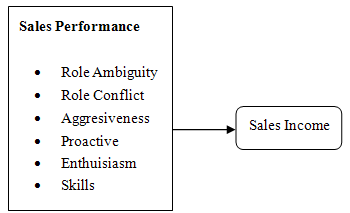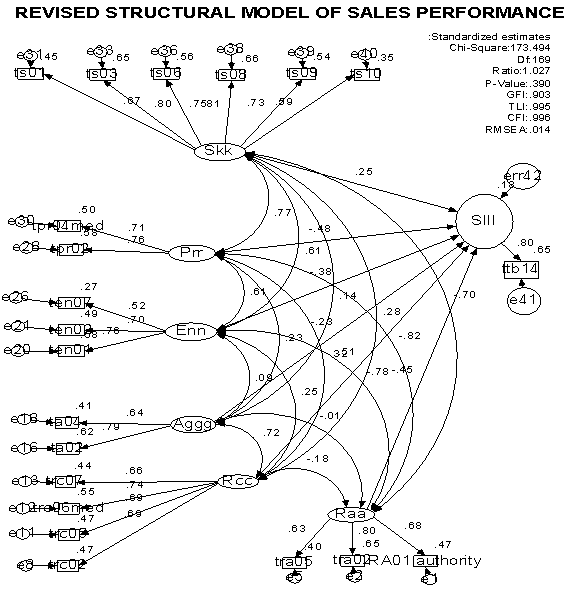-
Paper Information
- Next Paper
- Previous Paper
- Paper Submission
-
Journal Information
- About This Journal
- Editorial Board
- Current Issue
- Archive
- Author Guidelines
- Contact Us
American Journal of Economics
p-ISSN: 2166-4951 e-ISSN: 2166-496X
July, 2012;
doi: 10.5923/j.economics.20120001.23
An Analysis of Alternative Causal Models of Sales Performance on Sales People
Nadiah Ahmad , Nik Kamariah Nik Mat , Muhamad Faiz Mohamed Isa , Sarina Ismail , Mohammad Harith Amlus
Othman Yeop Abdullah Graduate School of Business, Universiti Utara Malaysia, Sintok, 06010, Malaysia
Correspondence to: Nik Kamariah Nik Mat , Othman Yeop Abdullah Graduate School of Business, Universiti Utara Malaysia, Sintok, 06010, Malaysia.
| Email: |  |
Copyright © 2012 Scientific & Academic Publishing. All Rights Reserved.
This paper explores the factors that influence the sales performance of sales people. Specifically, the objective of this study is to determine the relationships between role ambiguity, role conflicts, aggressiveness, enthusiasm, proactive, skills towards the sales income among sales people. All variables were measured from developed instrument using 7-point Likert-Scale: role ambiguity (6 items), role conflict (8 items), aggressiveness (5 items), enthusiasm (7 items), and skills (10 items) as exogenous variable while sales income (1 items) was measured using the ratio coding as endogenous variables. A total of 150 sales people, based on random sampling method selected from various age, gender and education participated in this study by responding to structured questionnaires. The instrument is validated using exploratory factor analysis (EFA) resulting in six similar components as the exogenous. The data was then analyzed using Structural Equation Modeling (SEM). The result shows that the goodness of fit indices of structural equation model are achieved at GFI=0.903, P-value=0.390, RMSEA=0.014 and ratio (cmin/df)=1.027. The finding supports one significant direct effect in the revised model, thus supporting the hypothesis regarding role conflict is positively related to sales income (β=0.509, CR=2.040, p<0.050).
Keywords: Role Ambiguity, Role Conflict, Aggressiveness, Enthusiasm, Proactive, Skills, Sales Income, Sales Performance, Sales People
Article Outline
1. Introduction
- The salesperson's role has become increasingly more demanding and complex. Salespeople contend with escalating customer expectations, more competition arising from globalization, more and rapidly changing technology, continuous marketplace change, the increasing prevalence of Internet usage by customers, and less differentiation in products and services[1]. Sales managers have always tried to understand the determinants of good sales performance. In response to this interest, researchers have examined many possible determinants of sales performance over the past 75 years. The studies have produced very inconsistent results with respect to what factors affect sales performance and the strength of the relationships[2]. Past reviews of the salesperson performance literature have not provided an adequate explanation for the observed inconsistencies. Part of the problem is that all of the reviews have been narrative. Though a narrative review affords the opportunity for special insight about the classification of phenomena and limitations of the studies, it is not the most effective way of generating a consistent summary of results.Selling is a matter of persuading, convincing, or influencing, selling is the transfer of ideas or property to another for consideration. What is it about selling today that is more difficult, and more importantly, what can be done to more effectively leverage people, process, technology, or knowledge to address those challenges.From the studies, most of researcher highlight the sales performance (Role ambiguity, Role conflict, Aggresiveness, Enthusiasm, proactive, Skills) which had a significant to sale incomes.
2. Literature Review
- Before specifying the relationships in our proposed model, we brief each construct of variables which are sales performance (Role ambiguity, Role conflict, Aggresiveness, Enthusiasm, proactive, Skills, and sale income.
2.1. Sales Performance
- Sales performance defined as any company that sells products to customers uses a form of sales performance measurement to evaluate an employee's quality of work and help pinpoint development areas.
2.2. Role Ambiguity
- Role ambiguity refers to the perceived lack of the necessary information a salesperson requires to perform their role properly. The important of understanding role ambiguity among marketing professionals operating at the boundary of an organization has been recognized by marketing scholars for some time[3]. Marketers have produced an impressive body of research on role ambiguity’s organizational determinants and its impact on job outcomes in a wide range of baoundary-spanning roles[4]. Role ambiguity is an important concept in role theory as well as in path-goal theory of leadership. All role concepts, role ambiguity has received perhaps the most criticism. For in-stance, King and King[5] observe that conceptualization and operationalization "issues for role ambiguity are greater concern. In comparison with role conflict, role ambiguity is more amenable to managerial intervention, implementing programs that diminish boundary role ambiguity is relatively less difficult. Studies involving role ambiguity have yielded inconsistent results. That such inconsistencies may stem from deficiencies in measurement (King and King[5]), a focused study of the role ambiguity construct may provide clues to such contradictory findings. Perceived role ambiguity occurs when salespeople do not think they have the necessary information to perform the job adequately[6]. Churchill et al.[6] comment that salespeople experiencing role ambiguity feel uncertain about how to do certain tasks, what the sales.
2.3. Role Conflict
- Role conflict relates to the perceptions of a salesperson that the expectations of two or more members of their role set are incompatible[7].
2.4. Aggressiveness
- Aggressiveness is the willingness to actively oppose someone else’s position, interests, or point of view, even it could adversely affects that other person[8].
2.5. Proactive
- The best approach to a sales performance review is a proactive one. Good sales techniques call for tracking performance throughout the year, which provides the information for continued success, and the trends for a very effective review[9]. Proactive is sales techniques are actions any person can do to increase profit. Simple advice such as pre-qualifying leads, respecting and listening to the client, building a relationship and setting realistic goals may seem intuitive for some, but many times are not implemented in pitches, emails, phone conversations and marketing materials[10].
2.6. Enthusiasm
- Enthusiasm is impassioned conviction with superlative description and visual demonstration that instills excitement about your offering’s life-changing solutions to your customers’ secret desires. Enthusiasm is one idea that will do more than multiply your income[11].
2.7. Skills
- It is necessary for salespeople to have the skills to listen effectively to customers’ needs, present the features and benefits of their products to clients, and guide customers to a buying decision, in many industries, that is not sufficient to create high sales performance. The value of these skills was effectively demonstrated in a study with a large European company. Three key strategic drivers showed significant improvement after salespeople completed a process designed to teach them business consulting skills. When compared to salespeople who did not receive the consultant skill development, these salespeople showed 18 percent greater increase in sales, 11 percent greater increase in new customer sales, 5 percent greater increase in the average size of each sale. The results provide strong support for the value of business consulting skills, and the ability of an effective training process to transfer learning to job performance. Past study suggests that providing salespeople with skills to be effective business consultants can provide an important source of competitive differentiation. By learning a consultative process, identifying appropriate methods for understanding the customer’s business, and then applying these methods effectively, salespeople will approach their clients more strategically and generate more profitable and compelling solutions for their clients. The better business consultants salespeople are, the more successful their sales performance. Sale income In the securities business, increased centralization suggests that salespeople are unable to apply their own discretion in deciding actions that they think is appropriate in a particular trading situation. For example, the salespeople are unable to decide which stocks to sell or to utilize whichever sales techniques they feel work best. Furthermore, when decisions are made at the top in the organizational hierarchy, sales personnel are likely to experience role ambiguity[12].
3. Methodology
3.1. Research Framework
- The following is the diagram of the research design to be used in this study.
 | Figure 3.1. Theoretical Framework |
 | Figure 2. Revised Model on Sales Performance |
4. Findings
- A hypothesized model based on the literature was used to analyze how role ambiguity, role conflict, aggressiveness, proactive, enthusiasm and skills influenced sales performance of the sales people. The goodness of fit of the model, our hypothesized model results (Chi-squares=228.142, df=210, Ratio=1.086, p>0.05, GFI=0.889, RMSEA=0.025). The data was input into SPSS 14 and analysis result shows that there is a Hey-Wood Case on the Sales Income measurement. The data was then analyzed using SEM through AMOS 16.Therefore, we adjusted the model based on Hair et al (2006) in this study. The result showed a good fit between the adjusted model and the empirical data given by the sample group. (Chi-squares=173.494, df=169, Ratio=1.027, p>0.05, GFI=0.903, RMSEA=0.014). The result from the adjusted model were able to specify the path coefficient of exogenous variables, which were defined as the causal factors of the sales performance of the sales people presented in Figure 2.As shown above diagram, the sales performance and role conflict is found to be significant at <0.05.
|
|
5. Discussion
- This study has established one direct causal effects; role conflict and sales performance. Interestingly, we found that the factor loading of role conflict shows a significant effect with sales performance; while there is no significant effect between role ambiguity, aggressiveness, proactive, enthusiasm and skills towards sales performance. The first effect was supported by previous study which is by[7], but only some of previous study supported the second effect. It is because the items of the variable influenced the results of the variable.
ACKNOWLEDGEMENTS
- We would like to thank Prof Dr. Nik Kamariah Nik Mat and Sukma Pea for their helpful comments and assistance on an earlier version of this paper.
 Abstract
Abstract Reference
Reference Full-Text PDF
Full-Text PDF Full-Text HTML
Full-Text HTML